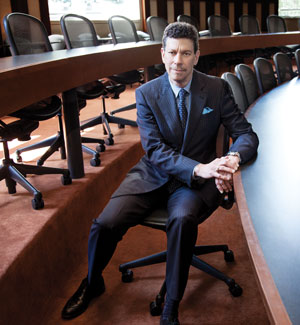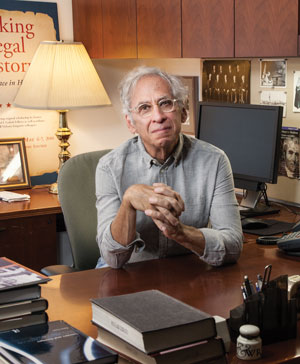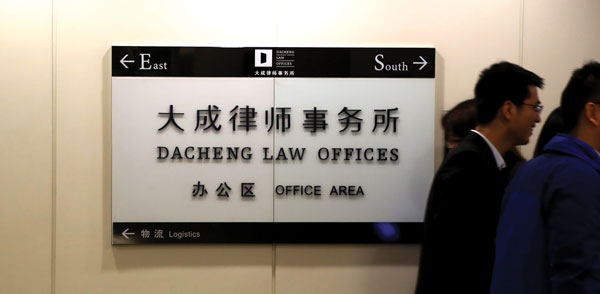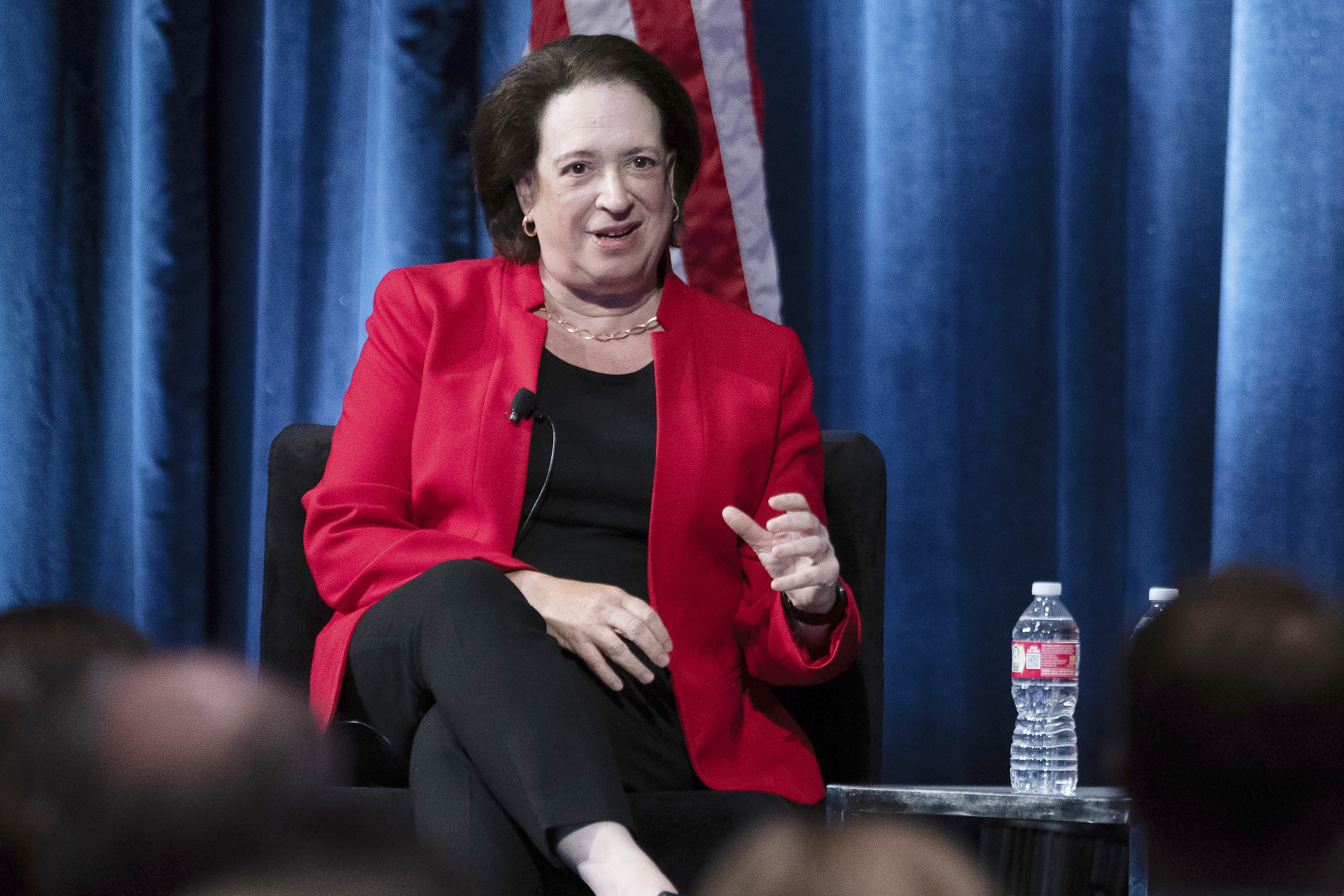The Rise of the Megafirm

Illustration by Michael Morgenstern
With that acquisition, the lawyer count will approach 7,000, a larger population than many small towns. That’s roughly 60 percent larger than the next-largest firms, Baker & McKenzie and DLA Piper, each of which has between 4,000 and 4,500 lawyers.
Dentons’ aggressive expansion has forcefully raised anew two questions that have dogged the legal profession since the dawn of global megafirms: Exactly how big is too big? And can you still call it a law firm?
Harvard Law School professor David Wilkins, whose research focuses on the legal profession, says the first question likely dates back to the mid-20th century, when the very first law firm grew to 100 lawyers. But the answer is really no clearer today.
“It’s not as if there’s some natural limit on how big a law firm should be, or what should be its natural size,” Wilkins says. “But it is true that, as these firms get bigger, they face a whole variety of different and more difficult challenges.”
At least some of the difficulties of expansion have been ameliorated by the vehicle that Dentons, Baker & McKenzie, DLA Piper, Hogan Lovells, Norton Rose Fulbright and some other very large firms have chosen to carry their ambitions forward: the Swiss “verein,” which is German for the word association.
Normally, when two law firms merge, they combine their separate partnerships into one. This can be a challenge, especially if there are large financial disparities between partners at the different firms. In recent years, rapid expansion via merger has been a factor in firm collapses like those of Dewey & LeBoeuf and Bingham McCutchen.
Vereins can avoid these issues to a large degree because they include multiple partnerships that, though they adopt a common brand and some management functions, remain legally and financially distinct. With separate profit pools, these entities simply don’t face the kinds of sticky economic integration issues that traditionally merged firms do. For instance, Dentons and Norton Rose each have five such entities, while DLA Piper has three.

David Wilkins. Photograph by Len Irish
Though firms of such unprecedented scale no doubt face challenges, law firm consultant Peter Zeughauser points out that size confers advantages too. “No one can hire you if they have never heard of you,” he says. “The more lawyers you have, the more likely it is that clients who may want to hire you will have heard of you.”
Zeughauser notes that many firms define their markets more narrowly than the Dentons of the world, making size less important to them. But firms like Dentons view their potential market as broadly as possible.
“Thus, they need to be big,” Zeughauser says. “For them, big denotes the ability to serve clients globally with multiple teams across the globe. Being the biggest can validate the proposition that a firm can do this. Being among the largest is likely all it takes to get on the short list.”
Though one could hardly call a firm like Dentons a boutique, Wilkins does see it filling a kind of niche, not unlike firms that focus on technology deals or capital markets transactions. “There’s a huge amount of work for someone who can handle a transaction that touches 15 or 20 countries,” he says, “and we’re seeing people moving into that niche.”
‘RARELY REWARDED’
On the websites of verein firms, one can usually click to find a lengthy disclaimer. In the case of DLA Piper, the legal notices tab reads in part: “The use of the name ‘DLA Piper’ and words or phrases such as ‘firm,’ ‘law firm’ or ‘international legal practice’ is for convenience only and does not imply that all or any of such entities are in partnership together or accept responsibility for the acts or omissions of each other.”
Hence the hue and cry that verein mergers don’t result in “real” law firms.
“If you live long enough—and I have—you learn that shortcuts are rarely rewarded in the long term,” says Peter Kalis, chairman of 2,000-lawyer K&L Gates. “Vereins are a shortcut for law firm leaders who weren’t prepared to do the heavy lifting of a real law firm merger.”
Kalis has been a particularly outspoken critic of vereins among firm leaders; he took to the pages of The American Lawyer in 2011 to criticize the inclusion of verein firms in that magazine’s Am Law 100 survey. His firm is also no stranger to mergers. Most famously the result of the 2007 combination of Pittsburgh’s Kirkpatrick & Lockhart and Seattle’s Preston Gates & Ellis, K&L Gates has added a number of other firms since then, including the Chicago firm Bell, Boyd & Lloyd in 2009 and the Australian firm Middletons in 2013. All of them now exist in the same profit pool.
The lower billing rates and profitability of Australian firms relative to their U.S. and U.K. counterparts played a role in some firms’ decisions to expand in that market via verein (Norton Rose) or alliance (Linklaters). But London’s Herbert Smith decided on a full financial merger when it paired with one of Australia’s largest firms, the 1,000-lawyer Freehills, in 2012.
“The reason we thought it was so important to have one profit pool is it leads to the sort of behavior we want to encourage, which is cooperation, collaboration—no silos,” says Sonya Leydecker, chief executive officer of Herbert Smith Freehills. “There’s also the quality issue—the reason people will refer work to their partners is they know they’re of a certain standard and they will treat their clients well. If you’ve got a shared economic interest and you spend time getting to know your partners in different places and working with them, you’ve got a better chance of making it work.”
That is very much the traditional view of how law firms work best, perhaps best exemplified in the U.S. by elite Wall Street firms that dominate high-end capital markets and mergers and acquisitions work. Firms such as Cravath, Swaine & Moore and Wachtell, Lipton, Rosen & Katz, as well as a handful of others, often not only have a single profit pool but lockstep compensa-tion, in which partners are paid strictly according to seniority instead of business origination. The goal is to create a culture where, rather than feeling competitive with each other, partners are closely bonded and likely to put the interests of the firm ahead of their own.
But the new verein firms are very much about challenging such traditional notions.
As for Dentons, global chairman Joseph Andrew and global chief executive officer Elliott Portnoy declined interview requests for this article, but they spoke to this reporter at some length just after the announcement of the Dacheng deal in January. Andrew called Dentons the “most integrated law firm in the world.” But he allowed that what integration means at Dentons might be different from what it means at other firms.
“I’m not talking about cultural integration, where we’re all singing from the same page,” he said. “We have different cultures within Dentons, and we celebrate that. But we have a common culture of getting the deal done.”
Dentons takes its present name from the former British firm Denton Wilde Sapte, but the leaders of its current incarnation are American. Portnoy and Andrew were both partners in the Washington office of Chicago’s Sonnenschein Nath & Rosenthal. Andrew was chairman of the Democratic National Committee from 1999 to 2001, and Portnoy became firmwide chair in 2007. At the time, Sonnenschein numbered fewer than 700 lawyers, but it more than doubled in size three years later via its verein combination with the former Dentons. In 2012, French law firm Salans and Canada’s Fraser Milner Casgrain were both added as separate vereins. Dacheng became the fifth entity within Dentons; McKenna Long’s partnership will be integrated into the firm’s North American verein.
Dentons’ culture of getting the deal done, Andrew explained in January, means that local partners who know their markets best will work with companies on the ground level. As those clients’ needs expand internationally, other offices within the firm’s global network will step in to handle transactions higher and higher up the value chain. Partners will be bound together by financial incentives pegged to referrals within the network.
“At Dentons, we recognize the fundamental question is how to incentivize lawyers to pick the right lawyer for the right job,” said Andrew.
ETHICS CHALLENGE
To some, such talk raises eyebrows. Edwin Reeser was a Los Angeles partner at the former Sonnenschein from 1998 to 2008 and, for that reason, he declines to comment on the specific activities of the current Dentons. But he has been an outspoken critic of the verein structure in general on ethical grounds.
Though he acknowledges that it’s hardly an issue confined to verein firms, Reeser laments that the huge emphasis large firms now place on internal referrals often means putting the firm’s interest before the client’s.
“Let’s say I’ve got a real estate deal in New York but I’m not licensed there,” he says. “The pressure that you have is to refer that to the real estate department in New York in your firm. Now I can refer this client to the best real estate lawyer we’ve got in New York, or I could refer to the best lawyer in New York for this kind of work, who, 95 percent of the time, is going to be someone who works at another firm.”
But specifically with regard to verein firms, Reeser wonders how they can create a centralized pool of funds, then redistribute it as meaningful referral incentives to individual lawyers across the member firms and not have that be regarded as profit-sharing in violation of their verein charters. On top of that, he has a hard time seeing how such arrangements can sit well with ethics rules that are based on ABA Model Rule 1.5(e), which governs the divisions of fees among lawyers working at different firms. According to the Model Rule, such divisions need to be fully disclosed to clients and specifically agreed to in writing. The fee must also be reasonable and in proportion to the services performed by each lawyer. Alternatively, the lawyers may assume joint responsibility for the representation. Reeser and another California lawyer, Martin Foley, first raised these questions in a 2013 article at ABAJournal.com.
“In the years since we wrote that, I have not had one person, ever, explain to me or the public at large how it works without violating the rule,” Reeser says.
But Stephen Gillers, a legal ethics professor at New York University, says criticisms of vereins based on Rule 1.5(e) seem off base to him, though he acknowledges that the answer is not certain. “The arguments are more formal than practical,” he says. “Why do we have the rule? It is to protect the client who has a right to know where the money is going—in effect, who it is paying and for what. Given the purpose of the rule, what doesn’t the verein client know that it would know if it were hiring a nonverein? As a practical matter, it’s in the same position. It doesn’t know money is divided within the firm.”
Gillers also questions whether verein members would be treated as distinct firms if the issue ever arose. “The fact that they publicly present as a single firm and apply the same conflict rules throughout all offices of the firm makes it unlikely that a regulator will challenge the method used to share profits,” he says. “Even more, for there to be a challenge, a client would have to complain and it is remote in the extreme that the big clients of vereins would care about this issue.”
While their financial arrangements have yet to come under scrutiny, verein firms’ public presentation as single firms has been the source of recent controversy. In July, a U.S. International Trade Commission judge disqualified Dentons from representing an Ohio company suing the Gap Inc., on the grounds that the retail giant was a longtime client of the law firm’s Canadian arm. Dentons is challenging the ruling. Not everyone agrees with Gillers’ view that vereins publicly present as single firms, or at least consistently do so. The issue arose last summer in a suit brought by the estate of legendary actor John Wayne against Duke University over the school’s opposition to its plan to market a “Duke” whiskey. The Wayne estate moved to disqualify Norton Rose as counsel to the university on the grounds that it was conflicted out because a partner in the firm’s Canadian verein was a longtime adviser to the co-plaintiff in the case. The case was dismissed on jurisdictional grounds in September, but it has since been seized upon by verein critics.

Stephen Gillers. Photograph by Len Irish.
“Vereins are schizophrenic,” says Kalis of K&L Gates. “The left side of the brain is concerned with marketing and talks about ‘seamless one-firm service.’ The right side of the brain is concerned with limiting liability to clients, conflicts of interest and financial integration, so it talks about ‘distinct separate entities.’ Really? Do they think no one is watching? That no clients are bright enough to figure this out?”
Of course, conflicts are an issue for all large firms, verein or otherwise. To the extent they may prove a bigger problem for vereins, it’s mainly because that structure has made it easier for firms to grow ever larger.
“The bigger a firm is, the more likely it will confront conflicts,” says Gillers. “This is pure math. More lawyers means more clients and more clients means greater potential for conflicts between clients.”
But Gillers points out that large firms have long dealt with these kinds of issues, often by getting clients to sign conflict waivers. Sometimes, these are sought at the very beginning of representations, though courts have sometimes rejected such “advance” waivers as insufficiently specific. “The conflict rules pose a practical problem to large firms, but there is nothing in those rules that caps their size,” he says.
Wilkins also thinks the evolution in clients’ thinking about conflicts means they won’t necessarily be an obstacle to continued law firm expansion. “If you look at what most large law firms think of conflicts today versus what they thought in, say, 1982, it’s a dramatic difference,” he says, “and, of course, when it comes to conflicts, at the end of the day the people who are going to decide what the conflicts rules are aren’t the bar regulators. It’s the clients because, almost always, clients are able to waive whatever rules there are or establish new rules like positional conflicts that aren’t in the rules.” A positional conflict arises when a law firm argues a position for one client that is directly contrary to an argument it is making on behalf of another client in a different matter.
“Clients don’t have legal problems; they have problem problems,” Wilkins goes on, “of which the legal part they would like to reduce to as small a part as possible so they get on with the things that are important—which is what’s happening with their business, what’s happening with their strategy, what’s happening with their people. These problems are fundamentally not just multijurisdictional, but they’re also multidisciplinary.”
NEWEST RIVALS
The Big Four accounting firms—Deloitte, Ernst & Young, KPMG and PricewaterhouseCoopers—are the best examples today of the multidisciplinary approach, combining audit, consulting and legal services. Their rise as rivals to international law firms in the market for legal services has been a major focus of Wilkins’ research in recent years. Though their push to expand in the legal market in the U.S. foundered in the wake of the Enron scandal, which led to accusations of conflicts and ultimately the collapse of audit firm Arthur Andersen, they have continued their legal offerings abroad.
“The Big Four are huge in the market for legal services everywhere but the United States,” Wilkins says, pointing out that most have applied to practice law in the United Kingdom under the alternative business structures provision of the 2007 Legal Services Act, which liberalized the British legal profession. But they have probably made the most strides in developing markets. “If you ask someone who is the best law firm in, say, Tajikistan, chances are it’s someone like Deloitte,” Wilkins says.
Global expansion is difficult for many traditional law firms, as it generally has to be financed directly out of partners’ profits. For leading American firms, that can be even harder to stomach because billing rates are generally much, much lower than they are at home. Cravath famously closed its Hong Kong office in 2003 because Asian clients’ demands for steep discounts clashed with its strategy of focusing only on the highest-value work. In contrast, multinational corporations generally have shareholders or investors who are more willing to wager on future growth. The Big Four, each of which has annual revenue more than 10 times that of even the largest law firm, can draw on their much larger capital structure to finance expansion.
In Wilkins’ view, the verein model is one way law firms are trying to address that investment gap. “So people start moving towards a structure where they don’t have to have a common profit pool and they move towards various strategies and combinations that allow them to expand without putting too big a drain on the people who, right now, are funding that,” Wilkins says.

SIGN OF THE TIMES: Chinese lawyers walk past the meeting area of Dacheng Law Offices in Shanghai. The international law firm Dentons and China’s Dacheng have agreed on a merger that will create the world’s largest law firm. IMAGINECHINA Via AP Images.
Moreover, to get into some desirable markets, there’s simply no other choice. Foreign firms are specifically banned from practicing Chinese law, a bar which has been widely interpreted as prohibiting traditional firm mergers. Most international firms operating in China focus on more general legal advisory or cross-border work. But for those that want to be seen as directly practicing Chinese law, a verein structure is now the only option. Before Dentons, the only other big law firm combination in the country—the 2012 deal that produced the Sino-Australian firm King & Wood Mallesons—also used a verein structure.
Most firms would like to establish themselves more in growth markets like China, where Dentons—via its combination with Dacheng—now counts 42 offices. Wilkins thinks that may be beneficial, perhaps not in competing with top-tier Wall Street firms for the blockbuster New York listings like that for Alibaba, but as China’s many provincial enterprises expand regionally or possibly abroad in other developing markets such as Africa, where Dentons has a presence in 18 countries.
Leydecker of Herbert Smith Freehills acknowledges the appeal of the verein growth model. “Looking at what people are doing, you can sort of see why you might do it,” she says. “In some cases, it leads to brand enhancement, at least in the short term.” But beyond that, she says, a lack of integration could later harm the brand if work quality is inconsistent across the network.
Wilkins sees that issue as well. “If all you’ve got is a common branding strategy, where you’re slapping a badge on things that have nothing in common, that only lasts so long,” he says. “People will realize there’s no common quality; there’s no actual way in which the parts fit together.”
Dentons faces a major integration challenge with Dacheng in particular, which operates in a legal market where there are no strong ethical guidelines and where the predominant culture at firms has been one in which partners cooperate rather than compete. Dacheng founder Peng Xuefeng, who will serve as chairman of the combined firm’s global board and head of its global advisory board, says the firms have agreed on a three-year transition period to bring their practices and procedures into line.
In Wilkins’ view, while the path ahead for individual verein firms is uncertain, their goal is a valid one.
“There are lots of risks in this and there are lots of reasons why it might not work, and it might not be Dentons Dacheng McKenna that’s going to work,” he says. “But here’s my prediction: People are going to make this work. There are going to be firms that start out as looser kinds of federations in order to build global capacity more quickly. They’re going to take advantage of gaps in the existing coverage. They’re going to market to clients who don’t have the ability to create their own very large and sophisticated internal legal departments. They’re going to have lots of fits and starts, meaning people are going to join and then some people are going to defect. They’re going to be more successful in some jurisdictions than others. But if the proposition is that any firm that starts out like this can’t succeed, I think that’s false.”
This article originally appeared in the September 2015 issue of the ABA Journal with this headline: “The Rise of the Megafirm: Dentons plans to count as many as 7,000 lawyers in its ranks, by way of an expansion that has been abetted by an increasingly common business structure used by the world’s largest law firms.”
Anthony Lin is a freelance writer based in Hong Kong.



